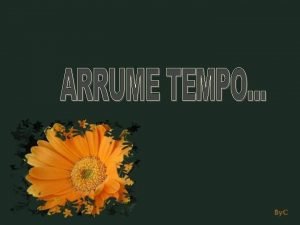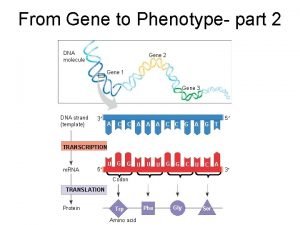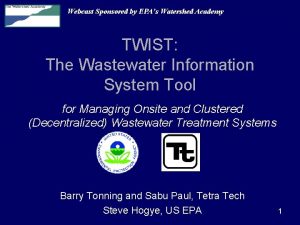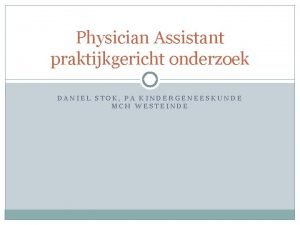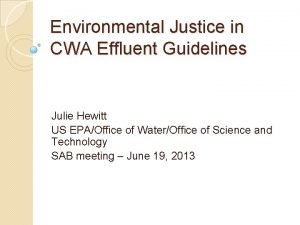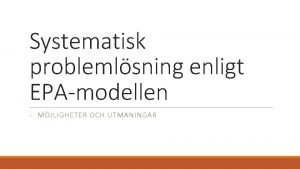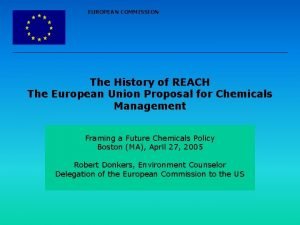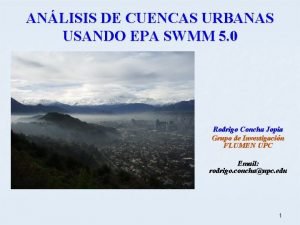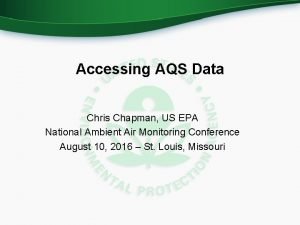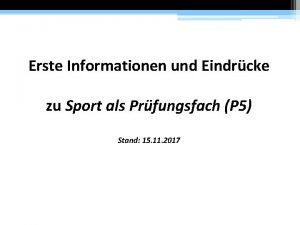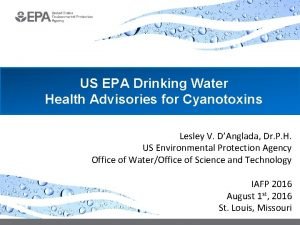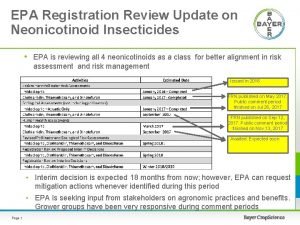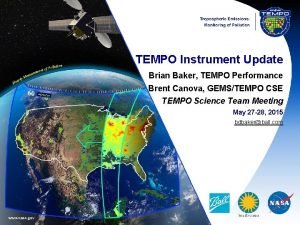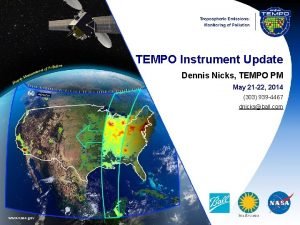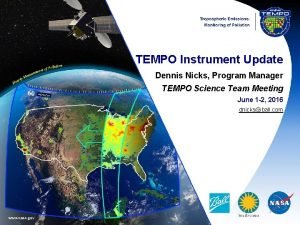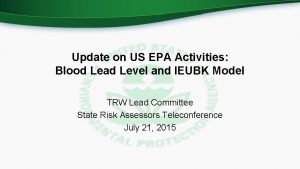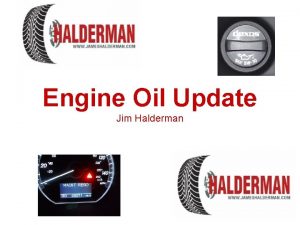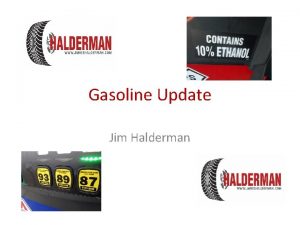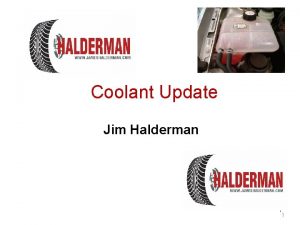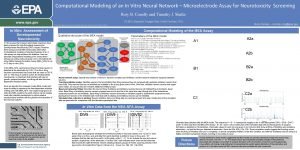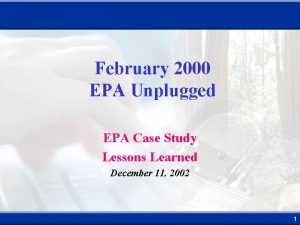Update on EPA TEMPO Activities EPA Jim Szykman













![Aeris Intercomparison with LIF Instruments [Aeris] = 1. 017(± 0. 005)[CAFÉ] + 0. 18(± Aeris Intercomparison with LIF Instruments [Aeris] = 1. 017(± 0. 005)[CAFÉ] + 0. 18(±](https://slidetodoc.com/presentation_image/10d0ac6f282c0ce3f6c8afa88cff0233/image-14.jpg)






- Slides: 20

Update on EPA TEMPO Activities EPA: Jim Szykman, Luke Valin, Andrew Whitehill, Kevin Cavender, David Williams, Russell Long + NASA: Bob Swap, Barry Lefer, Jay Herman, Nader Abuhassan, Alexander Cede (NASA/ESA), Travis Knepp (SSAI) + Harvard Smithsonian: Kelly Chance Virginia Tech: Elena Lind UMBC: Ruben Delgado and Vanessa Caicedo Plus NJDEP, NYDEC, CTDEEP, plus many others Email: Szykman. Jim@epa. gov and Valin. Lukas@epa. gov TEMPO Science Team Meeting June 6 -7, 2018 NCAR Boulder, CO 10/27/2020 1

Talk Outline Ø EPA Photochemical Assessment Monitoring Station Network Redesign Ø PAMS and Pandora Ø East Coast BEACON Ø Ceilometers Ø Formaldehyde Ø Summary 10/27/2020 2

Redesign of the PAMS Network • Major changes to the PAMS requirements were finalized in October 2015 as part of the ozone NAAQS review • EPA replaced the existing 20 year-old multi-site, enhanced ozone network design with an updated 2 -part network design: 1. Requiring PAMS measurements to be collocated with existing NCore sites in areas with population of 1 million or more irrespective of Ozone NAAQS attainment status I. Results in a stable network of approximately 40 required sites with improved spatial distribution and reduced redundancy II. Includes a waiver for historically low ozone areas III. Includes an option to make PAMS measurements at an alternative location (e. g. , an existing PAMS site) which may cross CBSA or even state boundaries 2. Require states with moderate or above ozone non-attainment areas and states in the Ozone Transport Region to develop and implement an Enhanced Monitoring Plan (EMP) I. Provides support for flexible approaches for collecting data to understand ozone issues in new and existing high ozone areas • 10/27/2020 States need to comply with the new PAMS monitoring requirements (begin operation) at NCore sites by June 1, 2019. Enhanced Monitoring Plans will be due within two years after EPA designates nonattainment areas or by Oct. 1, 2019*, whichever is later. (Designations made for most counties on 3

TEMPO Relevant Changes under PAMS Redesign Ø Requires 3 8 -hr carbonyls samples on a 1 in 3 day schedule • Included an alternative to allow for continuous formaldehyde measurements Ø Requires “true NO 2” in addition to existing NOy Ø Requires hourly mixing height measurement (replaces “upper air measurements”) • Added a waiver option to allow measurements to be made at an alternative location (e. g. , NOAA ASOS sites) Ø Require states with moderate or above ozone non-attainment areas and states in the Ozone Transport Region to develop and implement an Enhanced Monitoring Plan (EMP) 4 10/27/2020 4

EPA-NASA PAMS Pandora Collaboration Ø EPA is working with the NASA Pandora Project to develop a subset of surface air quality sites to host Pandora spectrometer instruments and contribute to larger Pandonia Global Network. Facilitated by Agency level EPA-NASA Memorandum of Agreement and TEMPO mission. Ø Initial focus is on deployment of Pandora as part of the Enhanced Monitoring Plan (EMP) requirements under the redesigned Photochemical and Assessment Monitoring Stations (PAMS) along with a select number of CASTNet sites. Ø DISCOVER-AQ, KORUS-AQ, plus other campaigns demonstrated Pandora is highly relevant to air quality and ability to provide observations of key O 3 precursors -NO 2 and HCHO. Ø Initial PAMS-EMP deployment included 9 long-term units (May 2019) within Ozone Transport Region at NYDEP, NYDEC, and CTDEEP sites. This effort also supports the Long Island Sound Topospheric Ozone Study (LISTOS Summer 2018) and on-going S 5 P TROPOMI validation. 10/27/2020 5

Phase I PAMS-EMP Deployment • CO, SO 2, true NO 2/NOy, O 3, PM spec. , mixing height, solar rad, BC, New Havn MET Hammonasset • O 3 + met Outer Island • O 3, CAPS NO 2, Mlh, + EPA LISTOS HCHO, NOy • EPA assets + F&W assets Westport • LIDAR, CO, O 3, PM, CO 2 B BG CCNY • LISTOSonly CO, Bayonne SO 2, NOx, O 3, BC, BTEX, MET Rutgers • CO, SO 2, NOx, O 3, Hg, PM 2. 5, carbonyl, toxics, hourly VOC, MET 10/27/2020 QC NY • CO, CO 2, SO 2, NOx, O 3, Hg, Acid dep, sulfate, PM 2. 5, carbonyl, toxics, hourly VOC, MET • CO, SO 2, NOx/NOy, O 3, PM spec. , BC, sulfate, carbonyl, toxics, MET Flax Pond • Future PAMS • O 3 and VOC guaranteed for summer 2018. NO 2 next priority. EPA owned Other, with coordination via EPA if needed 6

Pandora deployment under PAMS in OTR will provide a dense network for validation TROPOMI NO 2 over LISTOS Domain The presented work has been performed in the frame of the Sentinel-5 Precursor Validation Team (S 5 PVT) or Level 1/Level 2 Product Working Group activities. Results are based on preliminary (not fully calibrated/validated) Sentinel-5 Precursor data that will still change. Sentinel-5 Precursor is a European Space Agency (ESA) mission implemented on behalf of the European Commission (EC). The TROPOMI payload is a joint development by ESA and the Netherlands Space Office (NSO). The Sentinel-5 Precursor ground-segment development has been funded by ESA with national contributions from The Netherlands, Germany, and Belgium. 10/27/2020 7

Pandoras in the Ozone Transport Region Maine New Hampshire ACHD Bronx BG QCNY Rutgers PADEP CCNY UMBC NASA GSFC NASA HQ Mc. Millan VCU – Rice Center 10/27/2020 NASA La. RC Westport Rhode Island New Haven Hammonasset Outer Island Flax Pond Phase 1 EPAcoordinated. Spring 2018 Phase 2 EPAcoordinated. No later than summer 2019 Ongoing Operations 8

BEACON East 7 BEACON nodes in Bronx, Harlem and Fort Lee • Low-cost, low-maintenance sensor packages deployed at reference monitoring sites • Vaisala GMP 343 CO 2 (± 0. 5 ppm) Alphasense AQ sensor package (four gases), optical PM sensor • Provides valuable information on NOx emission rates (NOx mass/ CO 2 mass) a key uncertainty in developing O 3 control strategies • Will provide key information on how surface variations of atmospheric composition relate to spatially-detailed Geo. TASO column NO 2 measurements 10/27/2020 I 95 GW Bridge Near road High Precision CO, PM 2. 5, NO 2 GW Bridge Bronx Botanical Garden PAMS supersite IS 143 PM 2. 5 mass only New Jersey Morrisania II PM 2. 5 mass only Bronx CCNY O 3 High Precision CO 8 km × 10 km Manhattan IS 52 O 3, NOx, toxics, PM speciation, low-level SO 2 IS 45 PM 2. 5 mass only 9

Ad-hoc Ceilometer Evaluation Study (ACES) • Nov. 15 -Dec. 16, 2016 @ UMBC (Catonsville, MD) • EPA/NWS/UMBC Measurements to help guide EPA PAMS program implementation for new hourly MLH requirement and supplement current efforts under NWS ceilometer test bed. Instruments: Campbell Scientific –CS 135 (Viewpoint) Leosphere ALS-450 and 200 S Windcube (UMBC algorithm) Lufft CHM 15 K (Firmware 0. 73) i. Met-1 -ABxn 403 MHz GPS Radiosonde Radiometrics MP-3000 Sigma Space Micropulse Lidar Vaisala – CL-31 and CL-51 (BLView 1. 19), Digicora MW 41 (RS-41 and RS-92) Source: R. Delgado, 10/27/2020 10

Objectives: • Evaluate the range corrected attenuated backscatter from commercial ceilometers with a focus in the lowest kms. • Assess the daytime mixing layer height determination from commercial ceilometers: • MLH from vendor software vs. common algorithm across systems. • Focus on transition time periods. • What additional information can be gained from ceilometers, such as elevated layers aloft and entrainment? • Begin Prototype Development of Ceilometer Network under PAMS which includes a national archive and implementation of a common algorithm for MLH. Source: R. Delgado, 10/27/2020 11

Evaluation of Ceilometers for PAMS Mixing Level Height Requirement in differing Environments DISCOVER-AQ/FRAPPE (Jul-Aug 2014, Denver, CO) Low Aerosol Environment UWFPS (Jan-Feb 2017, Utah) High Aerosol w/ Cold Pool Inversions 10/27/2020 KORUS-AQ (May-Jun 2016, Seoul, S. Korea) High Aerosol Environment LMOS 2017 (May-Jun 2017, Lake Michigan, WI/IL) Low –Moderate Aerosol Land/Water Interface 12

Assessing the state of commercially available continuous HCHO measurements Ø PAMS requires 3 8 -hr carbonyls samples on a 1 in 3 day schedule. Continuous HCHO measurement can be implemented in place of EPA Method TO-11 A. Ø A Laboratory and Field Evaluation and Intercomparison of Ambient Formaldehyde Instruments lead by Andrew Whitehill (EPA-ORD-NERL) is currently planned for summer 2018 Manufacturer Instrument / Model Method Aerodyne Research, Inc. Aeris Technologies Mini-TILDAS Formaldehyde Monitor MIRA Pico VOC (HCHO Analyzer) MIRA Ultra VOC Portable (HCHO Analyzer) G 2307 Gasera ONE Formaldehyde Infrared absorption spectroscopy (1765 cm-1) Infrared absorption spectroscopy (2832 cm-1) Cavity Ringdown Spectroscopy Cantilever-enhanced Photoacoustic Spectroscopy Nanofiber Chemical Sensor Aeris Technologies Picarro Gasera Vaporsens (Prototype formaldehyde sensor) Ø Joshua Shutter (Keutsch Group) working with Aeris Technologies to evaluate performance of IR Absorption method. Ø City of Houston Health Department and Univ. of Houston (Flynn Group) working with Gasera to evaluate performance of Photoacoustic QCL Method. 10/27/2020 13
![Aeris Intercomparison with LIF Instruments Aeris 1 017 0 005CAFÉ 0 18 Aeris Intercomparison with LIF Instruments [Aeris] = 1. 017(± 0. 005)[CAFÉ] + 0. 18(±](https://slidetodoc.com/presentation_image/10d0ac6f282c0ce3f6c8afa88cff0233/image-14.jpg)
Aeris Intercomparison with LIF Instruments [Aeris] = 1. 017(± 0. 005)[CAFÉ] + 0. 18(± 0. 05) [Aeris] = 1. 015(± 0. 005)[ISAF] + 0. 21(± 0. 05) R 2 = 0. 976 R 2 = 0. 979 The Aeris sensor slightly overpredicts (<2%) when compared against research-grade LIF HCHO instruments. Offsets are less than ± 0. 3 ppbv. Bivariate least squares regressions were computed using the method of York et al. (2004) Harvard FILIF: Joshua Shutter and Frank Keutsch NASA ISAF and CAFÉ: Glenn Wolfe, Jason St. Clair, Tom Hanisco 10/27/2020 J. Shutter 6/5/18 Keutsch Group 14

J. Shutter 6/5/18 Keutsch Group Aeris Fit Int Time (min) 1σ Std Dev (pptv) 1 min 1000 15 min 227 60 min 136 ICOS Fit Int Time (min) 1σ Std Dev (pptv) 1 min 795 15 min 183 60 min 95 Average of Fits 10/27/2020 Keutsch Grouped developed their own fitting algorithm at Harvard (ICOS) to fit the data and compare it to the mixing ratio being reported by the Aeris sensor. While their fitting algorithm performs slightly better than the Aeris fit by itself, the average of the two fits yields better results. Int Time (min) 1σ Std Dev (pptv) 1 min 656 15 min 175 60 min 92 15

20+ year Bay Area MDA 8 ozone record (since 1995) HCHO concentrations as large as 40 ppb, columns as large as 4 e 16 in shallow PBL: Role of upwind biomass burning + local biogenic emissions ?

KORUS-AQ HCHO QCL Luke Valin KORUS provided evaluation of pandora spectrometer retrieval plus use of in-situ HCHO + ceilometer for mixing height to derive HCHO columns. The combination of these continuous measurements collocated can provide an important ground-based validation data set for Trop. OMI and TEMPO! Site pandora Profile shape Slope Box: measured MLH 1. 33 ± 0. 05 ceilometer Olympic Park Mt. Taehwa Intercept R 2 N 0. 34 ± 0. 03 0. 73 ± 0. 03 1280 - 1469 Box + exponential: measured MLH 1. 03 ± 0. 03 0. 29 ± 0. 02 0. 78 ± 0. 02 1280 - 1469 Box: median MLH 1. 34 ± 0. 01 0. 33 ± 0. 01 0. 67 1547 Box + exponential: median MLH 1. 06 ± 0. 01 0. 25 ± 0. 01 0. 68 1547 Box: measured MLH 0. 73 ± 0. 02 0. 47 ± 0. 01 0. 64 ± 0. 02 737 - 826 Box + exponential: measured MLH 0. 51 ± 0. 01 0. 46 ± 0. 01 0. 67 ± 0. 01 737 - 826 Box: median MLH 0. 67 ± 0. 01 0. 47 ± 0. 00 0. 59 879 Box + exponential: median MLH 0. 50 ± 0. 00 0. 47 ± 0. 00 0. 57 879 Spinei, E. , A. Whitehill et al. , The First Evaluation of Formaldehyde Column Observations by Pandora Spectrometers during the KORUS-AQ Field Study, AMTD 2018, 10/27/2020 17

KORUS-AQ Measured and Median MLH 10/27/2020 18

Stratosphere nt o d n Pa ~15 km Troposphere Absorption and Scattering by aerosols and molecules Absorption, Scattering and Transmission through a cloud Sa (al telli on te g l Sla igh nt t p Co at lu h) mn la ra S mn u l Co In-situ “True” NO 2 and HCHO analyzers Mixed Layer Height (measured by ceilometer) plus surface NO 2 can help provide a constraint on height of NO 2 profile with assumed vertical shape Pandora UV/VIS Spectrometer Ceilometer Absorption and Scattering by the surface Tropospheric Vertical NO 2 Column Vertical Stratospheric NO 2 Column ΩS – Slant NO 2 column ΩV - Vertical NO 2 Column ΩV = ΩS/AMF – air mass factor are sensitive to: -Viewing geometry -Terrain pressure and reflectivity -Shape of NO 2 vertical profile -Clouds and aerosols Pandora slant column determine from direct spectral fitting with ΩV = ΩS / secant[SZA]

Summary PAMS locations *BEHR Trop. NO Column May-July, 2015 -2016 2 Ceilometer Aerosol layer / mixing height measurement Ground-based spectrometer Column density O 3, NO 2, HCHO, SO 2 Improved trace -gas measurements Ø PAMS-EMP/Pandora effort: Ø Column measurements to support an improved assessment of emissions, chemistry, and dynamical processes driving ozone issue via daytime diurnal profiles of NO 2/HCHO in conjunction with other measurement suite consistent with the regulatory intent of the PAMS Ø Satellite validation TROPOMI & TEMPO – drawing a better connection on use/value and engages local AQ agencies. Ø Provides a sustainable low cost approach that mutually increases the value of measurement suite at these sites. 10/27/2020 20
 Is an alternative of log based recovery
Is an alternative of log based recovery Arrume tempo para quem tem tempo pra você
Arrume tempo para quem tem tempo pra você Perdemos muito tempo
Perdemos muito tempo Operating activities vs investing activities
Operating activities vs investing activities Group these activities into indoor and outdoor activities
Group these activities into indoor and outdoor activities Support activities and primary activities
Support activities and primary activities Definition of primary activities
Definition of primary activities Epa in ribosome
Epa in ribosome Epa watershed academy
Epa watershed academy Werkplekleren epa zorg
Werkplekleren epa zorg Julie hewitt epa
Julie hewitt epa Epa-modellen
Epa-modellen Epa pbt
Epa pbt Epa swmm descargar
Epa swmm descargar Epapack
Epapack Aqs data
Aqs data City and guilds epa price list
City and guilds epa price list Eqas gateway
Eqas gateway Epa economic partnership agreement
Epa economic partnership agreement Epa sport niedersachsen
Epa sport niedersachsen Epa
Epa

